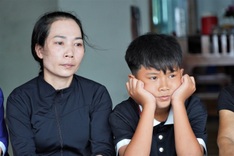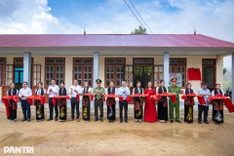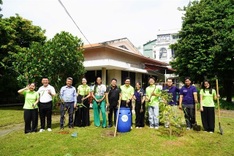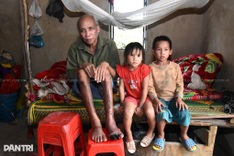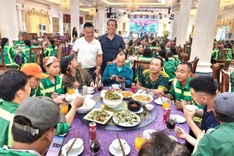Nguyen Duc Canh says he used to stay at Vietnam's only "1,000-star hotel." Translation: He grew up under a bridge. Abandoned by his parents in Hanoi, Canh sold chewing gum to tourists. When he was 8 years old, police officers took him to a government-run social protection center.
"It was a difficult life," Canh recalls. But with no education or support network, what was the alternative? He stayed at the center for 12 years, until a friend told him about KOTO -- Know One, Teach One -- a two-year program that trains former street kids to cook, wait tables and speak English.
Canh applied. Soon he was living in KOTO housing and slinging plates at KOTO's downtown Hanoi restaurant. When Canh wasn't serving green mango salad and KOTO mint juleps, he was studying English and learning about AIDS.
"KOTO taught me life skills and gave me a house and family," says Canh, a confident 21-year-old. "Now that I'm a waiter, I'll have more opportunities to find a job."

Cooks at KOTO.
KOTO is one of several training restaurants in Southeast Asia that offer hands-on vocational training to disadvantaged teens and twentysomethings. The entrepreneurs behind these "social enterprises" say they are helping young people to lift themselves out of poverty. At the same time, they say, their restaurants allow tourists, expats and middle-class locals to sample regional cuisine while doing a good deed -- and avoiding dodgy street food.
Street roots
The KOTO story began in 1996, when a tour guide named Jimmy Pham moved from Australia to Ho Chi Minh City, Vietnam. Pham, a Vietnamese Korean who grew up in a working-class, single-parent household, saw street kids selling coconuts near the Saigon Opera House. He bought them noodles and listened to their stories. A week later, the 24-year-old was renting them an apartment.
For the next 3 1/2 years, Pham supported street kids in Vietnam and Cambodia by subsidizing their rent, clothes, medicine and books. Handouts helped the kids survive, Pham says, but it wasn't enough. In 1999, to help them find steady employment, he opened a sandwich shop near the Hanoi Railway Station, where street children were earning money by shining shoes and selling postcards.
Pham had worked in his mom's butcher shop as a kid, but he didn't have any formal culinary training. So in his sandwich shop, he showed his chefs food photos from Woman's Day magazine. "They made terrible milkshakes and bland sandwiches," Pham recalls with a laugh. "But there was a sense of ownership."
The following summer, KOTO moved to an 80-seat space overlooking Hanoi's Temple of Literature. Pham's brother donated money for tables. Andreas Pohl, an Australian working in Hanoi for AusAID, helped Pham apply for embassy grants. Pohl's wife, Tracey Lister, a professional chef from Melbourne, volunteered to train Pham's staff and design a cafe-style menu. By November, KOTO kid-chefs were cooking lunch for then-President Clinton. (He ordered a grilled veggie, hummus and pesto sandwich, a mango lassie and a latte.)
Meanwhile, a similar story was unfolding in Phnom Penh, Cambodia, where a young Frenchman, Sebastien Marot, had opened a drop-in center for street kids in 1994 called Mith Samlanh ("friends" in Khmer).
"Why don't we start a training restaurant?" suggested Gustav Auer, an Austrian chef who came to Phnom Penh as a volunteer in 1999. Auer thought a tapas-style international restaurant wouldn't just help Mith Samlanh students find good jobs but would fill a culinary niche in a city overrun with awful food. His all-Cambodian teaching staff helped student chefs brainstorm weekly specials. They hung a sign outside a bright-yellow building that read, "Friends the Restaurant."
Tourists arrived en masse, Auer recalls, and Friends the Restaurant broke even after one year. Now, besides Friends, Auer supervises Romdeng Restaurant, a second Phnom Penh training location specializing in Cambodian regional specialties, and Makphet, a training restaurant serving "modern Lao food" in Vientiane, Laos. Auer says Romdeng, which reported a profit in 2008, attracts an equal number of Westerners and Cambodians. Earlier this year, the Miele Guide named Makphet one of Asia's finest restaurants.
Tastes of place
Menus at these training restaurants reflect research and enterprise. Lister, the Australian chef who designed KOTO's first menu, took a two-month eating tour of Vietnam. Auer and his Phnom Penh staff scoured the Cambodian countryside on motorbikes. That was the only way to find provincial recipes, he explains, because the Khmer Rouge had erased chunks of the country's culinary heritage.
Research paid off. KOTO serves such Vietnamese staples as bun cha (grilled pork with sticky rice noodles) and bun bo nam bo (beef noodle soup with peanuts and fried shallots). At Romdeng Restaurant -- the name is Khmer for galangal, a relative of ginger -- a colorful menu lists entrees such as "Didi's Famous Fish Amok in Banana Leaf" and "Khmer Fish and Tomato Ragout with Palm Sugar and Green Mango." At Makphet -- Lao for "chili" -- student-chefs cook the traditional dish mee gah tee (fish curry with rice noodles).
On a recent Thursday afternoon at KOTO, German tourists were raving about their Hue spring rolls and Dalat vegetables tossed in oyster sauce as they ate in the restaurant's airy third-floor dining room. (The first two floors were full.) Their tour company, Studiosus Reisen München, has been taking groups to KOTO for five years. A trip leader said eating at the training restaurant is an easy way to sample local dishes while supporting a good cause.
Service was an afterthought. "You see they're not highly skilled, but they do it with emphasis," Wolf Gierth, a member of the group, said of KOTO's wait staff. "You get the impression that they're learning."


